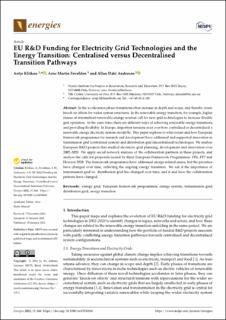EU R&D Funding for Electricity Grid Technologies and the Energy Transition: Centralised versus Decentralised Transition Pathways
Peer reviewed, Journal article
Published version

Permanent lenke
https://hdl.handle.net/11250/3015640Utgivelsesdato
2022Metadata
Vis full innførselSamlinger
Sammendrag
In the acceleration phase transitions often increase in depth and scope, and thereby create knock-on effects for wider system structures. In the renewable energy transition, for example, higher shares of intermittent renewable energy sources call for new grid technologies to increase flexible grid operation. At the same time, there are different ways of achieving renewable energy transitions and providing flexibility. In Europe, important tensions exist over how centralised or decentralised a renewable energy electricity system should be. This paper explores to what extent and how European framework programmes for research and development have addressed and supported innovation in transmission grid (centralised system) and distribution grid (decentralised) technologies. We analyse European R&D projects that studied electricity grid planning, development and innovation over 2002–2020. We apply social network analysis of the collaboration partners in these projects, and analyse the calls for proposals issued by three European Framework Programmes: FP6, FP7 and Horizon 2020. The framework programmes have addressed energy-related issues, but the priorities have changed over time, reflecting the ongoing energy transition. We ask if the importance of transmission grid vs. distribution grid has changed over time, and if and how the collaboration patterns have changed.